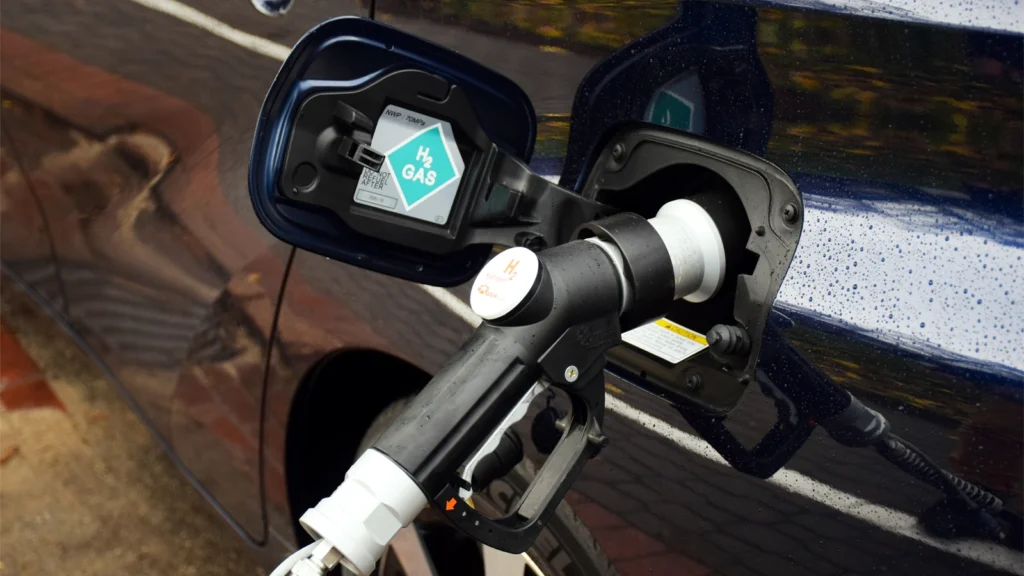The ex rocket engineer’s plan to build 2,000 hydrogen refuelling pumps by 2030

Hydrogen cars, trucks and buses have been around for a couple of decades now.
Plenty of manufacturers have pumped copious amounts of cash into developing the tech to become the low-carbon fuel of the future.
Yet, despite all the fanfare, hydrogen vehicles haven’t exactly become the must-have item in the UK – unless, of course, you’re living in Germany, California, or South Korea.
But that’s about to change…
Meet Tim Harper

Enter Tim Harper – ex-European Space Agency engineer, World Economic Forum Advisory Board Member, and Yorkshireman.
He’s the CEO and Founder of Element 2, a company that was birthed during lockdown, and he has got quite the plan to kick-start the hydrogen revolution in the UK.
Element 2, which began as a small project just four years ago, has grown into a serious player in the hydrogen game.
Tim has gathered a team of 12 scattered across the country, all working to solve what’s arguably hydrogen mobility’s biggest (and possibly only real) adoption challenge – infrastructure.
Hydrogen infrastructure
Element 2 has some ambitious targets planned. They’re planning to go public by the end of the year, with a goal of building out a national network by 2027.
By 2030, they aim to have upped that number dramatically to 2,000 pumps.
These aren’t pie-in-the-sky numbers either – they’re backed by a practical plan that involves co-locating these stations at existing fuel sites.
Rather than ploughing multi-millions into on-site electrolysers like Jo Bamford’s Motive Fuels, Tim’s taking a simpler, more cost-effective route.
The idea? Stick a hydrogen tank in every filling station, stocked with “low carbon hydrogen” sourced from suppliers.
If you’ve ever had an LPG-powered car, the process will feel pretty familiar. Element 2 will pay some ground rent, share revenue with the landowner or fuel station provider, and voilà – a network of hydrogen refuelling stations is born.
Tim’s strategy is built on the principle of supply creating demand. By making hydrogen as accessible as petrol, he’s betting that the market will follow.

Why this approach matters
This straightforward, no-nonsense approach is key to mass adoption. Tim isn’t wasting time on complicated set-ups or new-fangled tech that’s still years away from being viable.
Instead, he’s leveraging what’s already there – established infrastructure and proven methods.
And it’s not just about making hydrogen available – it’s about making it affordable.
Tim is targeting a price of £9 per kilogram of hydrogen, with plans to reach diesel parity within the next two years. That’s a big deal in a world where cost is often the deciding factor for fleet operators.
Strategic rollout: Where and when
The rollout won’t be random either. Element 2’s focus will be on high-demand areas first – think major routes, and near large truck depots.
Trucks and buses are the low-hanging fruit here; hydrogen is a much more practical, real-world solution than BEV tech. In fact, there are already 147 truck stops identified across the UK where these hydrogen stations could be set up.
Tim has also been in talks with major truck manufacturers to align the rollout of refuelling stations with the production of hydrogen-powered vehicles. So when these vehicles hit the road, they’ll have somewhere to refuel.
Industry relationships and competitive landscape
Tim isn’t doing this alone. Element 2 has built solid relationships with key players across the industry. They’re working closely with the Road Haulage Association, partnering with Riversimple for urban rollout strategies, and they’re well-acquainted with Toyota – a company that has been pushing hydrogen vehicles for years.
Local authorities in Teesside have also shown support, but national government backing remains minimal, with only the possibility of some carbon credits in the mix.
As for the competition? Tim’s not losing sleep over it. The major fuel companies like BP, Shell, and Esso are hesitant to shift away from their cash cow – petrol and diesel – because, well, why ‘fix’ what’s making money?
Their plan seems to be to let start-ups like Element 2 do the heavy lifting, and if it works out, swoop in with an acquisition later down the line.
As for other hydrogen start-ups, Tim reckons their models are a bit too complicated and costly, making Element 2’s approach not just practical, but potentially dominant.
The future is hydrogen – and it’s closer than you think
The hydrogen revolution in the UK isn’t just a pipe dream – it’s already in motion.
Element 2’s plan is realistic, grounded, and most importantly, already happening.
The team has done its homework: they’ve got the plans, the certifications and the testing completed.
They’re ready to scale up, and in T-minus-one-year, Tim hopes to start rolling out the first of these hydrogen stations.
So, watch this space – because hydrogen adoption in the UK is about to take off, and if Tim Harper has anything to do with it, it’ll be sooner rather than later.
Next time you’re at a forecourt, don’t be surprised if you’re given the option to fill up with the fuel of the future.










